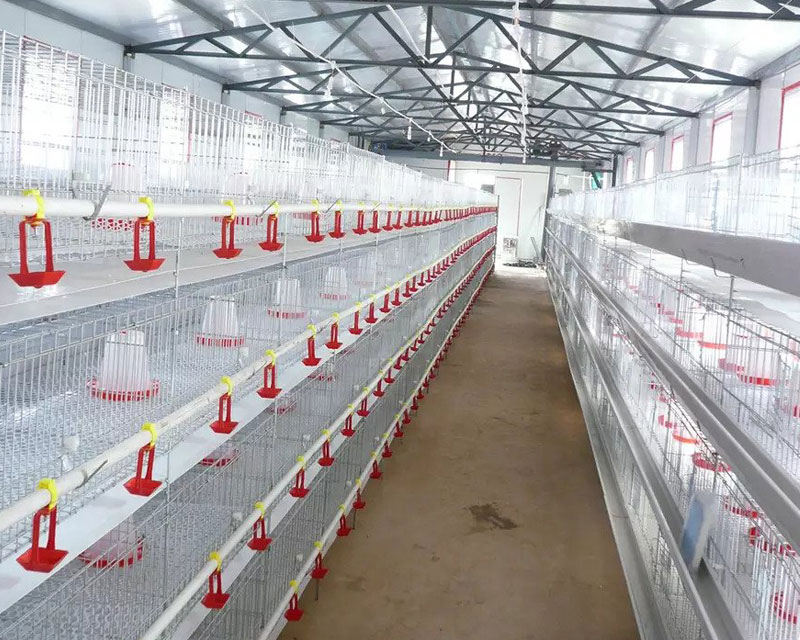Three Ways Of Chicken Farming: Battery Cage System, Slatted Floor System, Deep Litter System
Chicken farming is an important aspect of agriculture, providing protein for human consumption and providing a livelihood for many farmers worldwide. The raising of chickens for meat and eggs has evolved and there are now several methods of chicken farming, each with its advantages and disadvantages. This article will introduce the three main methods of commercial chicken farming, namely the battery cage system, slatted floor system, and deep litter system.
Battery Cage System
The battery cage system is one of the most common methods of chicken farming, particularly in industrial settings. In this system, chickens are housed in small wire cages, with multiple chickens in a single cage. The cages are stacked on top of each other to conserve space, and the chickens are fed and watered automatically.

Advantages
- The battery cage system is efficient in terms of space utilization, as the cages can be stacked to accommodate more chickens.
- The automatic feeding and watering systems reduce the time and labor required for feeding and watering the chickens.
- The cages keep the chickens confined, which can reduce the risk of disease transmission.
Disadvantages
- The battery cage system provides limited space for the chickens, which can result in poor welfare.
- The confinement can also lead to aggression and feather pecking among chickens.
- The cages are difficult to clean, and the accumulation of manure can lead to poor air quality and potential health problems for the chickens.
Slatted Floor System
In the slatted floor system, chickens are housed in a barn or shed, with a slatted floor to allow manure to fall through to a collection area below. The chickens are free to roam within the shed and are fed and watered manually or with automated systems.

Advantages
- The slatted floor system provides more space for the chickens, which can result in improved welfare.
- The manure collection system helps to keep the barn cleaner and reduces the risk of disease transmission.
- The slatted floor system can be more environmentally sustainable, as the manure can be collected and used as fertilizer.
Disadvantages
- The slatted floor system requires more space compared to the battery cage system.
- The chickens may be at risk of predation or escape if not properly secured.
- The slatted floor system may require more time and labor for cleaning and manure management.
Deep Litter System
In the deep litter system, chickens are housed in a barn or shed with a deep bedding of organic material, such as sawdust or straw. The chickens are free to roam within the barn and are fed and watered manually or with automated systems. The bedding material is periodically cleaned and refreshed to maintain a comfortable environment for the chickens.

Advantages
- The deep litter system provides more space for the chickens, resulting in improved welfare.
- The bedding material helps to absorb moisture and reduce the risk of disease transmission.
- The deep litter system is environmentally sustainable, as the manure can be collected and used as fertilizer.
Disadvantages
- The deep litter system requires more space compared to the battery cage system.
- The chickens may be at risk of predation or escape if not properly secured.
- The bedding material can become contaminated with bacteria, which may pose a health risk to the chickens.
In conclusion, each method of chicken farming has its advantages and disadvantages, and the best method will depend on the specific needs and circumstances of each farmer. In terms of equipment, the battery cage system requires chicken cages, automatic feeding and watering systems, and a manure collection system. The slatted floor system requires a barn or shed with a slatted floor, feeding and watering systems, and a manure collection system. The deep litter system requires a barn or shed, bedding material, feeding and watering systems, and a system for periodically cleaning and refreshing the bedding.
Regardless of the method of chicken farming chosen, it is important to prioritize the welfare of the chickens and to provide them with a clean, comfortable, and safe environment. This can be achieved through regular cleaning, proper ventilation, and adequate space, as well as by providing the chickens with access to food, water, and sunlight.
Overall, chicken farming can be a lucrative and rewarding industry, but it requires careful consideration and planning to ensure the success and sustainability of the operation. By choosing the right method and investing in the necessary equipment, farmers can provide a high-quality source of protein for human consumption while also providing a livelihood for themselves and their communities.

 4 Tier H Type Broiler Cage Project In South Africa
4 Tier H Type Broiler Cage Project In South Africa Layer Cage Project In Cuba
Layer Cage Project In Cuba H Type Layer Cage Project In Southeast Asia
H Type Layer Cage Project In Southeast Asia A Type Layer Cage Installed In West Africa
A Type Layer Cage Installed In West Africa Nigeria H Type Layer Cage Project
Nigeria H Type Layer Cage Project H Type Layer Cage Installed In Togo
H Type Layer Cage Installed In Togo